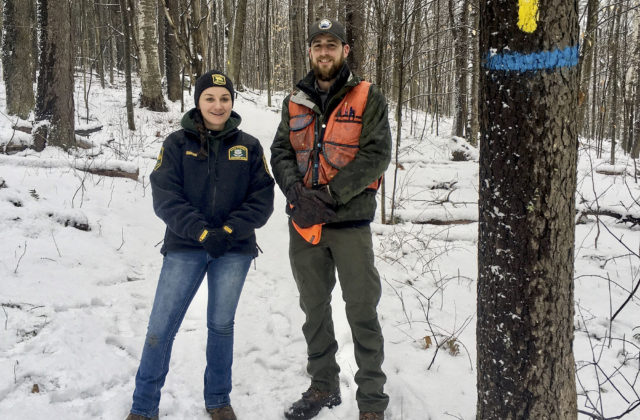Tree Cutting at Haystack Mountain State Park
Text and Photo by David Beers
A century ago, the Stoeckel family’s generosity provided to the state both the land and the tower that now make Haystack Mountain State Park the icon of Norfolk. Back then, most of the forest on the lower slopes of the mountain was young saplings. That fledgling forest is now all grown up, and its health is threatened—particularly by the Emerald Ash Borer (EAB), a beetle from Asia.
Our corner of Connecticut is the last area with some ash trees not infested by EAB, but that is quickly changing. Just a half hour to the south and east, most of the ash are dead or almost dead. Once the ash is infested, the living inner bark (phloem) usually gets eaten within a growing season by the EAB larvae, and the tree is dead soon thereafter. Not all infested trees have the ‘blonding’ caused by the woodpeckers pecking away the tree bark to eat the beetle larvae, and without blonding, the only direct evidence of the borer is the ‘D-shaped’ beetle exit holes in the bark.
Dead, or mostly dead, ash trees are dangerous because the dead crown limbs are very brittle and break easily. It is much safer to cut the trees before they become a public hazard, which is what the state is attempting to do on their properties. In Western Connecticut, the ash have been harvested from many state forests and a few state parks, including Mount Tom State Park in Litchfield and Dennis Hill State Park here in Norfolk. The only time state parks are considered for forest harvesting is when there is a need to salvage hazardous trees caused by widespread mortality (hurricane, tornado, fire, exotic pest).
Stephany Dumond is the park supervisor for the state parks in Norfolk. Dumond emphasized that the state is in the process of removing over 20,000 hazardous trees that have been GPS-mapped in public-use areas in state parks and forests, which is a monumental task. Her road maintenance crew began removing hazardous dead ash trees along the road up the mountain. Once they started, this job started to seem like a bottomless pit, and it was decided to look into conducting a timber harvest that would make revenue rather than spending money on removing ash trees. This is when State Forester Jeremy Clark was called in to evaluate the park’s forests.
Any proposed DEEP harvest starts with writing a forest operation plan that is based on a thorough forest inventory. This plan is then reviewed by experts in wildlife, fisheries and recreation. The 386-acre Haystack Mountain Park was evaluated for high concentrations of ash trees. Clark identified two areas in particular: the lower slopes surrounding the road on the south side of the mountain and the far northwestern portions of the park. The northwestern area is rarely visited, and the ash there will be allowed to become wildlife snags. The southern area is a high-use area loaded with trails, roads and picnic stops that make dead ash trees a public hazard. This 45-acre area will have most of the ash trees removed as part of a revenue-producing timber harvest.
Clark did leave some large ash trees standing that have wildlife cavities, particularly when they were not near trails or roads. He also marked for removal some other non-ash trees that were either in poor health or had defects making them prone to structural failure. The trees with blue horizonal slashes are being removed for lumber and the trees with blue vertical slashes are being removed for firewood. The double marks are the edge of the harvest area. The pink and black flagging indicates the main logging trails. There will be five sites, called landings, for trucks to load logs. Two of these landings are next to roadside picnic sites and will be converted to parking areas when the harvest is done.
Like all DEEP timber harvests, this harvest will soon go out to bid to timber buyers (loggers and sawmills). It will be harvested with a mechanized harvester and a log forwarder when the ground is either dry or frozen. No logging debris (slash) will be left within 25 feet of roads, blazed trails and property boundaries. All slash will be cut down below 4 feet in height, and that height requirement gets lowered to 2 feet for areas within 50 feet of roads and blazed trails. When logging is active, the park will be closed to all public access in the timber harvest area.
The harvest will remove 125,000 board feet of timber, including 80,000 board feet of ash. Most of the revenue from the harvest will be reinvested in state lands management. In some areas only a scattering of trees will be removed, while in others quarter- to half-acre patches of trees will be removed. After the harvest, herbicides will be sprayed selectively on exotic woody invasive plants. These include barberry, honeysuckle, multi-flora rose, privet and bittersweet.
Clark recommends that private landowners with many ash trees in their forest can contact DEEP’s service forester, Larry Rousseau, for a free visit to their property to offer guidance on options available to them. Rousseau’s phone number at the DEEP Western District office is 860-485-0226.

